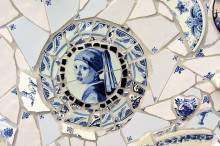9 AI-Generated Artworks Create the ‘Mona Lisa’ That Is Only Revealed When Put Together
Digital artist TDRAW used an AI art generator app to create a post-apocalyptic work of art made up of nine canvases.
Digital artist TDRAW specializes in artificial intelligence-generated art that explores fantastical worlds. One of his recently completed pieces depicts a cityscape from science fiction in nine different parts which, when put together, reveals another work of art: a silhouette resembling the portrait of the Mona Lisa.


